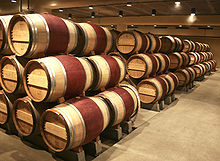Expansion (wine)
When expanding all wine-cellar work in the period between the end of the fermentation and bottling of a wine called. During the aging process, the wine develops complexity and structure. Depending on the grape variety , quality, style and wine tradition, this maturation can take place in barrels , barriques or tanks of various sizes. Depending on the type of wine, quality, potential and vintage, the maturation period can extend over a period of several weeks to years. The longer this maturation process lasts, the more expensive it is.
Wine treatment and stabilization
The expansion of the wine is usually associated with the first blending of the wine, racking , filtering and filling up of the evaporated wine, whereby the young wine is protected from air and thus from oxidation in order to preserve its reductive state . In addition, there are biochemical processes such as malolactic fermentation , also known as biological acid degradation. To stabilize it, the young wine is fined , followed by precipitation of tartar (potassium hydrogen tartrate) or colloidal tartar stabilization . The protection against later oxidation is achieved by sulfurization , which also has an antimicrobial, enzyme-deactivating and reducing effect, and has a positive sensorial effect on the product.
Expansion options
Depending on the intensity of air access to the wine, a distinction is made between oxidative and reductive expansion . Both options result in fine gradations, which are based on the manufacturer's style as well as the quality and variety.
For full-bodied wines, especially red wines , a moderately reductive expansion in wooden barrels is important. Through the dedicated contact with wood and, to a lesser extent, with oxygen , the wine is flavored (→ aromas in wine ) and receives an often rounded, harmonious, but always more varied taste (so-called complexity of the wine taste). With micro-oxygenation , the amount of oxygen can be increased in a controlled manner.
A more reductive-oriented expansion often takes place with white wines, which are produced for immediate consumption and should be less complex and storable. As a rule, they are matured in stainless steel or concrete tanks in order to emphasize the primary aromas and the freshness of the wine.
In any case, the components of the new wine should be integrated. Among other things, processes of acid degradation (especially malic acid ) play a role, as well as chemical changes in tannic acid , which reduce the astringency of the wine. Only when the quality of the wine is convincing does it end up in the bottling area and (if necessary after further bottle storage) finally on sale.
Duration of the expansion
The duration of the aging is different for each wine:
- In the case of white wines, the aging process usually takes until spring after the autumn harvest .
- Good red wine from Bordeaux can be stored in small oak barrels for 15 to 18 months.
- Spanish Gran Reserva are stored for at least three years.
- Tokaji Aszú is aged for at least three to six years, Aszúeszencia for ten years in small oak barrels.
- The sweet wine from Sauternes can be stored for up to three years.
- The Premier Grand Cru wine from Château d'Yquem is usually stored for four years.
- Port wines developed as Colheita must mature in barrel for at least seven years. Some port manufacturers age Tawny in casks for up to 40 years.
- Top quality, as Oloroso -developed Sherry may experience a 30- to 50-year barrel storage.
literature
- Helmut Hans Dittrich, Manfred Großmann: microbiology of wine. 3rd edition, Verlag Eugen Ulmer, Stuttgart 2005, ISBN 978-3-8001-4470-9 .
- Robert Steidl: Cellar economy. 7th edition. Österreichischer Agrarverlag, Vienna 2001, ISBN 978-3-7040-1699-7 .
- Gerhard Troost : Technology of Wine . 6th edition. Ulmer, Stuttgart 1988, ISBN 3-8001-5816-7 (standard work).
Individual evidence
- ↑ a b c Jancis Robinson: The Oxford Wine Lexicon. Hallwag Verlag, Munich 2003, p. 48.
- ↑ a b c d Horst Dippel : The wine dictionary. 4th edition, Fischer, Frankfurt am Main 2000, p. 32.
- ↑ S. Görtges: Metatartaric acid for tartaric stabilization ( Memento from August 15, 2016 in the Internet Archive ). In: Switzerland. Z. Obst-Weinbau , 2002, 1, pp. 8-9.
- ↑ Jancis Robinson: The Oxford Wine Lexicon. Hallwag Verlag, Munich 2003, pp. 572-576.
- ↑ Jancis Robinson: The Oxford Wine Lexicon. Hallwag Verlag, Munich 2003, pp. 675-679.
